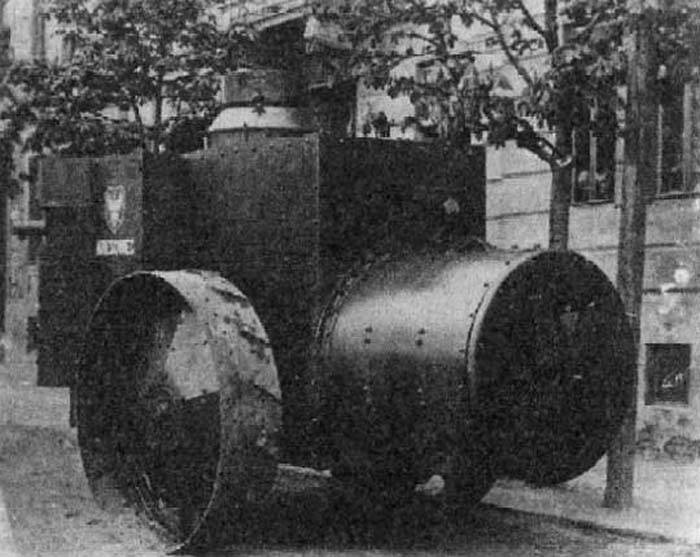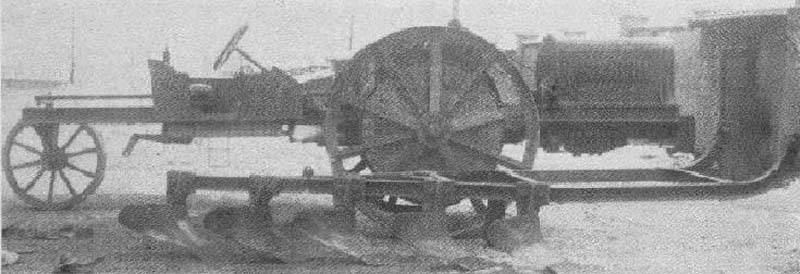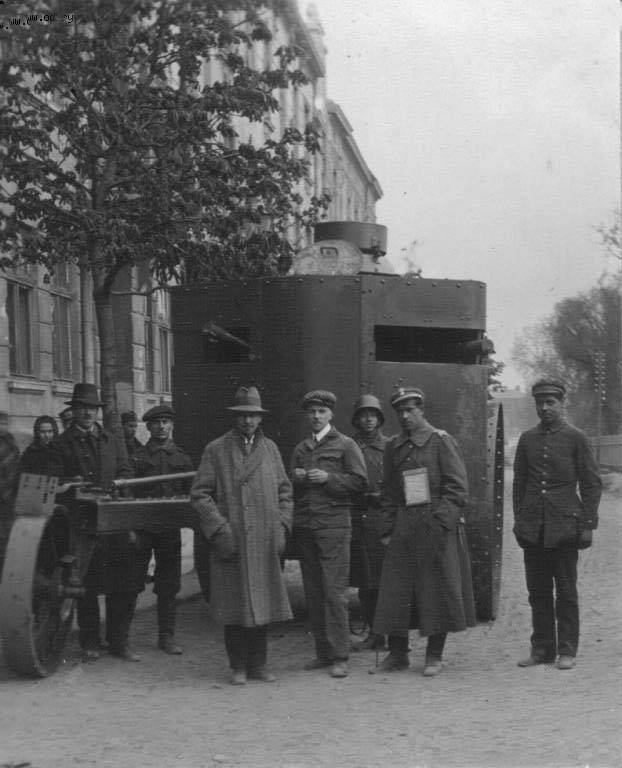Armored car Kresowiec (Poland)
One of the main areas of hostilities during the Polish-Ukrainian war was Galicia. Armed formations of the West Ukrainian People's Republic put up fierce resistance to the Polish troops, and the latter wanted to get some means of increasing their combat potential. By the end of 1918, it became clear that the most convenient and affordable means of this kind are armored cars. With its limited capabilities, Poland began developing a new combat vehicle.

Kresowiec armored car, front view
According to some reports, the initiative to create a new armored car, later named Kresowiec, did not come from the military. The collapse of the Austro-Hungarian Empire led to the redistribution of territories not only at the level of the newly formed states. In connection with the latest events, the peasantry’s speeches became more frequent, threatening large Polish landowners. The latter risked losing their lands, and therefore turned to the army for help. As a result of such events, the second Polish armored car appeared.
Regardless of the prerequisites for the appearance of the project, the process of its creation was as follows. At the end of 1918 of the year - obviously, not earlier than the last days of November - the commander of the technical defense of Lviv, Wilhelm Alexander Lutzke-Birk, and the designer Vitold Aulikh began to develop a promising armored car with anti-bullet protection and machine-gun armament. Preparation of design documentation did not take a lot of time, but the limited production capabilities seriously affected the overall terms of work performance.
A promising armored car was supposed to work in the border areas of the Republic of Poland and, apparently, it was in connection with this that he got his own name Kresowiec - “Border Guard”. Other designations or names were not used.
Poland did not have a developed industry, and therefore the project "Border Guard" immediately faced the most serious problems. In particular, its authors could not find a suitable truck chassis that could be equipped with an armored hull. The chassis problem was solved in the most interesting way. As the basis for the new armored car used self-propelled plow-tractor brand Praga. According to some reports, this agricultural machine, built in 1914, was given to the designers by one of the major landowners, directly interested in the earliest possible construction of an armored car.
The self-propelled plow was a three-wheeled machine of the most simple design, designed to work in the fields. The basis of this chassis was a narrow frame of large elongation, in front of which was placed the power plant. Behind her was a pair of large drive wheels, behind which was mounted a control post with a driver's seat. The rear frame beam, protruding beyond the limits of a similar "cabin", had a device for installing a small steerable wheel. In the initial configuration, such a machine had to tow a plow with several working bodies.
Praga plow was equipped with a hp 32 gasoline engine. With the help of a mechanical transmission with two forward gears, the torque was delivered to large drive wheels. The specifics of the work in the field identified the main features of the chassis. Thus, large drive wheels, built on the basis of spokes, were adapted for work on the ground and therefore equipped with wide rims with small lugs. The rear steering wheel had the simplest spoke structure and could not be completed with a tire. As part of the chassis there were no elastic elements.
The base machine differed in its rather simple design, which made it possible to build an armored car without significant reworking the chassis. According to some information, during the construction of the Kresowiec car, the project authors had to rework the control systems in order to turn the driver’s post backwards, but this information is not confirmed by other sources.
On top of the specific chassis mounted armored body rather simple design. It consisted of a set of armor plates 10 mm thick, mounted on the frame with rivets. Reservation differentiation or rational slope angles were not used. In addition, apparently, the internal volume of the hull was not divided into compartments, and the volume of the power plant was actually combined with the habitable compartment.
The front of the frame with the engine and gearbox covered the original frontal unit. The engine hood was made in the form of a horizontally mounted armored cylinder of sufficient size. There was a round frontal sheet, behind which was placed a cylindrical surface that served as the roof, sides and bottom. It is curious that such an armored hood protected the engine from all directions, including from below, than the corps of other armored cars of that time could not boast about.

Praga self-propelled plow that became the basis for an armored vehicle
Directly behind the cylindrical hood was a large rectangular unit that served as the front of the habitable compartment. It was distinguished by a greater height, whereas its width was limited by the size of the gap between the driving wheels. Behind the rectangular part of the armored case was a pair of protruding sponsons, which had a triangular shape. The stern sheet of the hull was located vertically and was made in the form of a curved part. On top of the car was protected by a horizontal roof.
In the central part of the building located turret, designed to monitor the surrounding area. The turret consisted of a cylindrical base of small height, on which a conical part and another cylinder of smaller diameter were placed. Between the two upper parts of the turret there was a gap, providing a free all-round visibility.
Chassis received only partial protection. The spokes of the drive wheels covered with guards in the form of truncated pyramids, assembled from several quadrangular sheets. The rear frame beam and steering wheel were completely located outside the armored hull and had no protection. However, the metal rear wheel and without protection are not exposed to special risks.
Kresowiez armored car armed with three machine guns. Available photos show that machine guns with a water-cooled barrel should have been fixed on the rigs. At the disposal of the Polish Republic at that time there were machine guns of various types that have a similar design. Thus, Austro-Hungarian MG 08 or Schwarzlose machine guns could be used on the machine. Also, some sources mention the use of Russian "Maximov". Anyway, the design of the armored corps provided for the installation of three machine guns.
The first machine gun was located on the installation of the front shell sheet. The ball mount was placed directly above the cylindrical hood and allowed to fire at targets in a small sector of the front hemisphere. The airborne sponsons received large openings of large width, behind which were mounted weapons mounting means. Two stern machine guns controlled sectors of greater width and, possibly, could simultaneously fire at certain parts of space. At the same time, significant sectors on the sides of the machine were not swept by any of the existing machine guns.
The crew of the armored car could consist of three or four people. In front of the habitable compartment were placed the control post and the workplace of one of the shooters. The other two shooters were supposed to work in the rear of the hull, in the side sponsons. Access to the car was provided by a door on the starboard, placed behind the drive wheel. There was also a sunroof behind the tower. Overview provided by several hatches. So, the front shooter and the driver had their hatches in the front sheet, and the view from the jobs of the stern shooters was provided with large openings in the sides.
According to known data, the total length of the Kresowiez armored car was 7 m. A pair of airborne sponsons brought the width of the car to 3,2 m. Height - 2,9 m. The combat weight was at the level of 7-8 t. Both in its original form and with the new armored plow chassis Praga could not show high performance. The maximum speed in the second gear of the two did not exceed 15-20 km / h. The increased load on the chassis seriously limited mobility on soft soils.
V.A. Lutzke-Birk and V. Aulich fairly quickly completed the development of the project, but the construction of an armored car of a new type was noticeably delayed. From one of the project initiators, the authors received a self-propelled plow of an available model. The construction of an armored corps was commissioned by one of the private Lviv workshops. In addition, railway workshops were involved in the works. Two companies jointly for several months managed to build a single armored car of a new type. Work on its assembly was completed only in May 1919.
The “Border Guard” armored car was built in the 1919 year, and this is where the information about it actually ends. This machine is mentioned in the context of some events, but there is no exact data to that effect. So, V.A. Lutzke-Birk later mentioned that the Kresowiez armored car was used during the battles in the Podzheuysky Garden, but did not provide details of these battles. Information about other operations involving the armored car is missing.

Ready armored car, stern view
The first armored car built for the Polish army in 1918 was primarily used in the battles for Lviv. After the capture of the city "Tank Pilsudski" was sent to other fronts of the Polish-Ukrainian war. Soon he joined the special platoon Zwiazek Aut Pancernych. It is possible that the “Border Guard” was also included in this division, but accurate information on this score was not preserved.
According to reports, the Kresowiez armored car was created not only to strengthen the army, but also to protect land ownership from encroachment. In this case, he had to fight with the armed detachments of the peasants, who had not the most perfect weapon and, by definition, did not have modern technology. Thus, in such conditions, as an advocate of land, an armored car could show good results. Bulletproof armor and three machine guns could be a serious argument in confrontation with poorly trained and armed infantry.
The meeting with the units of a full-fledged army, which has at least artillery, could be completed for an armored car “Pogranichnik” in the saddest way. 10-mm reservation protected only from bullets and shrapnel. In addition, some other design features, such as the presence of large openings in the sponsors and the lack of rear wheel protection, could have a negative impact on survivability in a combat situation.
Information about the combat path of the Kresowiec armored car, which became the second car of its class in the Polish army, has not been preserved. It is only known that he began his service in the spring of 1919. It can be assumed that for some time the machine remained in service, but then was destroyed in battle or written off after the development of the resource. One way or another, the armored car had to finish its service no later than the mid-twenties.
In connection with the beginning of the war, the Polish army needed different types of weapons and equipment, but the available capabilities did not allow to get everything desired. As a result, it was necessary to independently develop and build new cars, using only the available opportunities. The situation was such that the agricultural vehicle became the basis for the next armored vehicle. Unfortunately, most of the information about the operation of the Kresowiec armored car has not been preserved, but even without this data, this machine is of great interest from the point of view of technology and stories.
On the materials of the sites:
http://aviarmor.net/
https://dobroni.pl/
http://derela.republika.pl/
http://histografy.pl/
http://tanks-encyclopedia.com/
- Ryabov Kirill
- Dobroni.pl, Aviarmor.net
Information